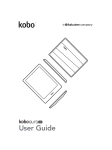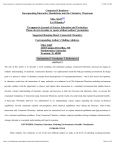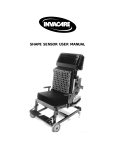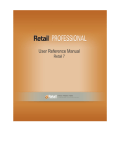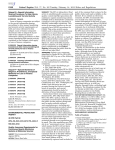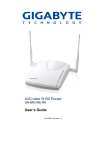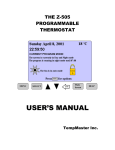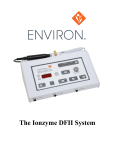Download View PDF - Hearing Loss Association of America
Transcript
Before the Federal Communications Commission Washington, D.C. In the Matter of: ) ) ) ) Comment Sought on 2010 Review of Hearing Aid Compatibility Regulations WT Docket No. 10-254 COMMENTS OF: HEARING LOSS ASSOCIATION OF AMERICA; Hearing Loss Association of America (“HLAA”) submits these comments in response to the request for comment sought on the 2010 Review of Hearing Aid Compatibility Regulations (2010 Review) released by the Federal Communications Commission (“FCC” or “Commission”) December 28, 2010. The Commission is required by law to ensure that persons with hearing loss have access to telephone service. In this 2010 Review, the Commission seeks to comprehensively evaluate: • the operation of the current hearing aid compatibility (HAC) rules; • their success in making a broad selection of wireless phones accessible to people who use hearing aids and cochlear implants; and • their success in making information about those phones available to the public. To provide the Commission with information from people with hearing loss who use, or have attempted to use, mobile phones, HLAA conducted an online survey of mobile phone use. The survey was open between January 28 and February 7, 2011. In that time, we received 728 comments. A summary of survey results is included as Appendix A 1. Technical assistance with survey development and data analysis was provided by Linda Kozma-Spytek, an investigator in the Rehabilitation Engineering Research Center (RERC) on Telecommunications Access funded by the National Institute on Disability and Rehabilitation Research (NIDRR). HLAA is in the process of a more in-depth analysis of the survey results and comments, which when completed will be available to the Commission on request. The results of the survey surprised us. We have received few complaints or questions directly from consumers regarding their experience in searching for and purchasing a mobile phone. We were also surprised that 728 people took the time to complete the survey, many of whom also provided additional comments; in addition, almost 100 people emailed us directly to provide 1 Appendix A. “Can You Hear Me Now? HLAA HAC Cell phone Survey” February 7, 2011. 1 more information about their experiences. One person who responded to the survey also sent a separate email with further comments gave us permission to include his experiences in our comments, attached here as Appendix B. 2 Questions in the survey focused on: shopping for a mobile phone, in-store testing of mobile phones, experiences with the mobile phone purchased, and experiences returning the mobile phone. Those responding are currently using mobile phones, or have shopped for a mobile phone recently. 52% reported purchasing their mobile phone in the last year, and another 36% purchased a mobile phone in the last 2-3 years. People responding were hearing aid or cochlear implant users, although some reported that they do not use their hearing aids or cochlear implant when using a mobile phone. 48% 3 of people responding typically use the microphone setting on their hearing aid or cochlear implant; 40% 4 use their telecoil setting, and 22% 5 use the speakerphone setting. 53% 6 increase the volume control on the mobile phone to hear comfortably. We were struck by several different issues: Interference is still an issue • 28% 7 of people responding to the survey reported experiencing interference half the time or more. 61% 8 report interference some or all of the time from the mobile phones they currently use. Responses to Question #29 on the HLAA Survey: o 13% yes, every time I use the mobile phone o 15% yes, half the time o 33% yes, a few times o 40% no, never • A third (33%) 9 reported experiencing “annoying” “very annoying” or “unbearable” interference on the phone they currently own. HAC mobile phones are important to people with hearing loss • People responding to the survey overwhelming (75%) 10 felt that in selecting a mobile phone for purchase, the HAC ratings were the “most important feature” or “one of the most important features.” • 78% 11 of people responding thought that 100% of mobile phones should be HAC. 2 Appendix B. Ibid. Question #24. 4 Ibid. Question #24. 5 Ibid. Question #24. 6 Ibid. Question #28. 7 Ibid. Question #29. 8 Ibid. Question #29. 9 Ibid. Question #30. 10 Ibid. Question #3. 3 2 M/T Ratings are confusing to consumers • However, there was a good deal of confusion regarding the M and T ratings. o 52% 12 did not know the M/T ratings of their current mobile phone; o 80% 13 did not know the M/T rating for the hearing aid. Finding information about HAC mobile phones is not easy • Many of those responding (41%) 14 turned to the sales clerk in retail stores as their source of information about HAC mobile phones, however, only 6%15 reported that the sales representatives were “very familiar” with HAC mobile phones. • Most people searched on line to find out about HAC mobile phones. (53%) 16 visited either the manufacturers’ or the service providers’ websites. However, over a third (35%) 17 found those sites either “not very helpful” or “unhelpful.” • Some had no idea where to find the information about HAC mobile phones at all. 14% 18 of written comments indicated that they never did get information about HAC mobile phones. Comments included: o I did not get information and it does not work o I did not receive any information from anyone o Did not get info - just make do In-store testing HAC mobile phones were not always available for in-store testing. • 36% 19 of those responding visited a service provider’s store that did not provide in-store testing. • 21% 20 reported finding all the HAC mobile phones available for in-store testing that they wanted to see. • 14% 21 reported that none of the mobile phones they wanted to see were available for testing in the store. • 97% 22 felt that no retail store should be exempt from providing in-store testing of mobile phones. Finding a mobile phone that works 11 Ibid. Question #11. Ibid. Question #22. 13 Ibid. Question #23. 14 Ibid. Question #4. 15 Ibid. Question #14. 16 Ibid. Question #4. 17 Ibid. Question #5. 18 Ibid. Question #4 19 Ibid. Question #16. 20 Ibid. Question #13. 21 Ibid. Question #13 22 Ibid. Question #17. 12 3 Most (67%) 23 reported they were able to find a mobile phone with the features they wanted at the price they wanted. However, • 14% 24 reported paying more for a mobile phone to get the HAC ratings they wanted. • 32% 25 reported purchasing a mobile phone that had more features or fewer features than they wanted in order to get the HAC rating they needed. • Despite being able to find a phone with features they wanted, a third (33%) 26 reported experiencing “annoying” “very annoying” or “unbearable” interference on the phone they currently own. Most do not return their mobile phones • The majority of people responding (84%) 27 had no experience returning their mobile phones. • Of those people who did return their mobile phones within the trial period and who identified themselves as a hearing aid and/or cochlear implant user, 17% (20/117) 28 were charged a re-stocking fee. Many people completing the survey took the time to write comments that made it clear whether they ended up with a mobile phone that was HAC for them or not, it had been an arduous task to find a mobile phone. Comments from those completing this survey include: o While M and T ratings are useful at the end of the day what matters is how you can hear on the phone and the only way you can do that is to require the carrier stores to have all phone (sic) live so that a person with hearing loss can do in store testing and select the best phone for them HAC or not. o I buy, hope for the best, and return it if necessary…kind of a horrible experience. o I’m disappointed that some of their newer models that I would consider looking at do not have the M4/T4 feature on them. So fare(sic) I can settle for less than that. o I have a cochlear implant and depend on the speaker which is very bothersome to others, and makes it impossible for privacy! …I would really prefer a bettr (sic) phone! I would be willing to break the current contract for a better phone! o Even if a phone is identified as hearing aid compatible that doesn’t mean it works with all kinds of hearing aids? Cell phone shopping and wireless accessory shopping is very frustrating. o I wanted a camera cell phone and go(sic) a M3/T3 …phone which I presumed would be hearing aid compatible (with my telecoil) but it produces too much interference…so I take the hearing aid out to use it. o I have not replaced my phone yet( but I spent 2.5 hrs in store) because once you get it you are pretty much stuck with it.. yes you get 30 days.. but I travel a lot and it's 23 Ibid. Question #20. Ibid. Question #20. 25 Ibid. Question #21. 26 Ibid. Question #30. 27 Ibid. Question #34. 28 Ibid. Question #34. 24 4 easy to miss 30 days. But it's really hard to make a decision at the store for several reasons.. the anti theft device is a hindrence to getting the phone where you need to have it. Then you have to have somebody to call and a program of dialogue in place and then you are also trying to figure out how to work the phone. o The bottom line: I haven't changed plans, didn't upgrade my…phone- rated M3which works okay in most places, hums loudly in others, and looks like it lost a fight with a snowplow. As long as it keeps working, I'll take my time researching all options. I feel lucky to be able to use a phone at all thanks to my CI, only wish the process of finding compatible phones were less convoluted. Our Conclusions It is clear that manufacturers and service providers are making and selling HAC mobile phones. However, the information about HAC mobile phones is not readily available to consumers, the task of finding and purchasing a HAC mobile phone is arduous, and consumers often feel “stuck” with mobile phones they do purchase. The fact that so many still report annoying interference on the mobile phones they do purchase suggests that this lack of understanding leads many to purchase and to keep a mobile phone that does not work well for them, either because they do not believe other phones will work for them, or they have a poor understanding of the return policy. Many complain bitterly of their experiences. We urge the Commission to re-evaluate the benchmarks for HAC mobile phones. If more HAC mobile phones were available, it would be easier for consumers to find HAC mobile phones that do work with their hearing aids. We also urge the Commission to use their own website to collect more data directly from consumers. As noted above, this survey, conducted only over 11 days, provided us with responses that were surprising to us. We believe ongoing input about consumers’ experiences is clearly needed. Those experiences should be provided directly to the Commission over the course of time, and be reported out to the community and to the communications and hearing aid industries. We suggest the Commission become an impartial clearing house of information for consumers that is easily searchable and provides all the needed information in one place. In addition, the Commission clearly needs to reach out to consumers to let them know they can be a source of information to them. Only 6% 29 of respondents went to the Commission website for information about HAC mobile phones. We urge the Commission to require manufacturers and service providers to improve their websites to make information about HAC mobile phones more easily and readily available to consumers by: 1. The use of searchable terms the consumer can use to find information about HAC mobile phones that are consistent across the industry, not just on a given website; 2. 29 Ibid. Question #4. 5 Grouping all HAC mobile phones together and in a way that is easily comparable; 3. Regularly updating the information on the website; 4. Creating industry-wide best practices and guidelines for websites. Considering most people appear to get their information from a visit to the retail store, we also urge the Commission to require service providers to make the following available at the site of sale: • Hard copy of fact sheets or brochures about hearing aid compatibility and HAC mobile phones; • Hard copy of lists of currently available HAC mobile phone models available for sale by the service provider; • All the service providers’ HAC mobile phones currently available for sale activated and ready for testing; • Staff who have received training in HAC phones and hearing aid compatibility, including: the meaning of the M and T ratings, where to find the HAC fact sheets, lists of phones and the HAC mobile phones for testing, and, when needed, how to turn on the HAC menu; • Display cards that include the M and T rating for each mobile phone; and • Physically placing HAC mobile phones together in the store. HLAA’s responses to the Commission’s questions: 1. Do the Commission’s deployment benchmarks appropriately ensure that hearing aid compatible handsets are available to all consumers? It’s our impression that the Commission’s deployment benchmarks do not appropriately ensure that HAC handsets are available to all consumers. In our survey, we found that 28% 30 of people responding reported experiencing interference half the time or more. 61% report interference some or all of the time from the mobile phones they currently use. 33% 31 reported experiencing “annoying” “very annoying” or “unbearable” interference on the phone they currently own. 32% 32 of the people responding had to purchase a mobile phone with more features or fewer features than they desired to get the mobile phone with the HAC rating they needed. 14%33 paid more than they wanted to get the ratings they needed. Others reported that they could only use their mobile phones taking their hearing aids out, or 30 Ibid. Question #29. Ibid. Question #30. 32 Ibid. Question #21. 33 Ibid. Question #20 31 6 used it despite interference because they felt they were “stuck” with the mobile phone they purchased. In addition, we received multiple comments regarding the onerous process of finding a HAC mobile phone. Had more handsets been available, the process of finding a HAC mobile phone compatible with a given hearing aid would be far easier. Having a few handsets coupled with limited information about how to find those few handsets is like finding a needle in a haystack: it leads to frustration, searches that take literally years, or settling for a handset that doesn’t quite work. In fact, fully 78% 34 of people responding to our survey indicated they thought 100% of mobile phones should be HAC. d. Are hearing aid-compatible handsets widely available across all market segments, including the prepaid phone market? We note that under the current rules, service providers must meet the hearing aid compatibility benchmarks across their entire product line, and are not required separately to account for the phones offered to different market segments, such as prepaid versus postpaid. Is there a need for rules specifically addressing the prepaid market or any other segment, and what would be the effects of any such rules on manufacturers or service providers? We do not have data on the prepaid market. Consumer perception of the prepaid market is that there is a disproportionate number of legacy mobile phones, compared to those provided under contract. We have also heard from consumers who have received a mobile phone in a box without the required information about its HAC rating. We believe that the industry should be reporting the prepaid market separately, to ensure HAC mobile phones are available in a full range of features and prices for the prepaid market. From our survey results, we suggest another segment of the market that appears to need specific rules is online purchase of mobile phones, whether prepaid or not. With no ability to test the mobile phone before purchase, the return policy for Internet sales must be generous, including a return policy that would allow a minimum of 30 days or more for return of the mobile phone and any accessories purchased with the mobile phone as well as a refund for all fees, including, but not limited to: • fees for the mobile phone and accessories purchased at the same time • activation fees • “re-stocking” or “cancellation” fees • for pre-paid mobile phones, fees for any unused minutes 2. Are hearing aid-compatible phones available to consumers with a full range of different feature sets? 34 Ibid. Question #11. 7 The HLAA survey revealed that in fact there are HAC handsets available with different feature sets. • 74% 35 found HAC mobile phones for the type of mobile phone they were considering. • 69% 36 were able to purchase a mobile phone with the features they wanted and the ratings they needed. However, others could not find the mobile phone with the features they were looking for and the HAC ratings they required. • • • 26% 37 could not find HAC mobile phones for the types of mobile phones they were considering. 20% had to purchase a mobile phone with more features to get the HAC ratings needed 12% had to purchase a mobile phone with fewer features to get the HAC ratings needed In addition, many people responding to our survey are reported experiencing interference from the mobile phone they purchased. Benchmarks should be increased so that more HAC mobile phones are available. Until such time that more mobile phones are HAC, the communications industry must find ways to ensure that those mobile phones that are HAC more easily found, tested, and returned if necessary. Sufficiency of Information 2. Are manufacturers’ and service providers’ websites providing useful information in an accessible manner? While 53% 38 of those responding indicated they got their information about HAC phones from the manufacturers’ or the service providers’ websites, only 29% 39 found the information on the manufactures’ and the service providers’ websites to be “helpful” or “very helpful”. While most websites do provide general information about HAC mobile phones, the issue appears to be that finding HAC ratings for particular models of mobile phones is cumbersome. 14% of those who commented (214 comments) on this issue had no idea where to find the information. Responses to a question about where they found out about HAC information resulted in comments revealing a total lack of understanding, including the following: I did not get information and it does not work 35 Ibid. Question #10. Ibid. Question #21. 37 Ibid. Question #10. 38 Ibid. Question #4. 39 Ibid. Question #4. 36 8 I did not receive any information from anyone Did not get info - just make do It appears that there is a great need for consumer education. Manufacturers’ and service providers’ websites should continue to provide basic easy to read information about HAC mobile phones, including information about the ratings. In addition, searchable terms that are consistent across the industry, not just on a given website, that allow a consumer to view all HAC mobile phones together and in a way that is easily comparable, would help consumers find and use the information they need for the website. Industry best practices and guidelines for these websites must be developed. In addition, information about available HAC mobile phone models is not easily found. Information on the HAC rating for individual models is often buried after a long list of other information about that phone is provided. As long as the benchmarks are so low that it’s difficult to find HAC mobile phones, we suggest greater consumer outreach, more easily searchable terms, and showing HAC phones in a dedicated spot on the website of the Commission as well as manufacturers and service providers. 3. Are the point-of-sale and packaging disclosures appropriately informing consumers? a. The rules require that manufacturers and service providers clearly display the hearing aid compatibility ratings on the packaging material of a hearing aid-compatible handset, and that they include an explanation of the rating system in the device’s user manual or as a packaging insert. Are manufacturers and service providers supplying this information, and are they doing so in a manner that is clear and helpful to consumers? Are consumers able to understand the hearing aid compatibility rating system? If not, are there any measures the Commission can and should take to improve the disclosures? Should such measures take the form of a rule or voluntary guidance? Fully 41% 40of people responding to our survey found information about HAC mobile phones from the sales clerk in the service providers’ stores, yet only 6% 41 reported that the sales clerks were “very familiar” with HAC mobile phones. Only 9% 42 of people indicated they were able to find HAC mobile phones without the help of sales people all of the time. 12%43 took the mobile phone home and read the manual. It appears that the way people with hearing loss purchase hearing aids is on a trial and error basis. Without fully understanding what a HAC mobile phone is or what the ratings mean, they visit the retail store and depend on a sales clerk, who also doesn’t know what the ratings mean, to guide them through the process. If they are lucky, there is a model with a list of features they want at a price they can afford that is also HAC. If they 40 Ibid. Question #4. Ibid. Question #14. 42 Ibid. Question #6. 43 Ibid. Question #4. 41 9 are unlucky, they are sold a mobile phone with a list of features they want at a price they want, but is not HAC. Because so many people rely on the store staff to get information the packaging disclosures and inserts appear to be irrelevant to their purchase decisions. Therefore, there is a need to educate consumers while they are in the store. We suggest: • Hard copy of fact sheets or brochures about hearing aid compatibility and HAC mobile phones; • Hard copy of lists of currently available HAC mobile phone models available for sale by the service provider; • All the service providers’ HAC mobile phones currently available for sale activated and ready for testing; • Staff who have received training in HAC phones and hearing aid compatibility, including: the meaning of the M and T ratings, where to find the HAC fact sheets, lists of phones and the HAC mobile phones for testing, and, when needed, how to turn on the HAC menu; • Display cards that include the M and T rating for each mobile phone • Physically placing HAC mobile phones together in the store. c. Are consumers adequately informed of the need to activate the hearing aid compatibility functions in their phones, particularly when used with hearing aids containing a telecoil? If not, what actions might the Commission take to promote more effective dissemination of this information? When asked whether they needed to set up a HAC feature on the mobile phone menu system, 36%44 did not know. 65% of those providing additional comment on this topic (220 comments) indicated that they “did not know,” “never found out” or “didn’t know set up might be required until this survey!” Only 15% 45 reported finding out from a sales representative in the store. The same brochure that provides general information, such as CTIA’s “Hearing Aid Compatibility with Wireless Phones and Services,” could be used to disseminate information about the HAC menus in addition to HLAA’s articles about HAC mobile phones, including “Choosing and Using a Cell Phone with Your Hearing Aid or Cochlear Implant.” That information should also be provided on service providers’ and manufacturers’ websites, along with the Commissions’ clearinghouse of information, when developed. d. Is there any additional information that should be made available to users of hearing aids or cochlear implants at the point of sale or in product manuals? How should any such additional disclosure be achieved? 44 45 Ibid. Question #31. Ibid. Question #32. 10 The return policy as it relates to HAC mobile phone purchase should be available in writing and in plain language at the site of purchase. 16% 46 of people responding to this survey had returned a HAC mobile phone because it did not work with their hearing aid or cochlear implant. Of those who returned the mobile phone within the return period and who identified themselves as a hearing aid user, 17% (117 comments) were charged a re-stocking fee. Considering several service providers have policy in place that waives the re-stocking fee if the mobile phone is returned because it is not compatible with the consumer’s hearing aid or cochlear implant, there appears to also be a need for training of staff on this subject. 4. Is the rule that requires phones to be made available for in-store testing effective? The current rules require that service providers offer in-store testing of hearing aid compatible handset models in each retail store they own or operate.40 Is the testing offered under this rule effective in helping consumers choose a hearing aid-compatible phone? What challenges have service providers encountered in offering effective in-store testing? Are there any rule changes or other Commission action that would make the testing more effective or efficient? The rule that requires mobile phones to be made available for in-store testing is clearly important. Because information about HAC mobile phones is difficult to find, because consumers do not understand the M and T ratings on mobile phones, and don’t know the M/T ratings of their hearing aids, the only sure way to know whether that mobile phone is compatible is to test it in the store. Consumers have found that some stores fail to have HAC models available for testing. Also, in some stores the anti-theft device has been placed on the phone precisely where is best used to test for hearing aid compatibility. In short, in-store testing provides a place for a consumer to get a snapshot of whether there is any interference at all and to test for volume control on the phone, but the phone must often be tested at home and work as well before the consumer can have a full picture of how the phone works with the hearing aid or cochlear implant. We believe a generous return policy as well as a policy that ensures there will be no restocking fee charge, is vital to account for the fact that in-store testing may not be able to reveal whether the mobile phone creates interference for the consumer in all settings. 5. What actions might the Commission take to provide better information to consumers with hearing loss who obtain phones from sources other than their service provider? In the Hearing Aid Compatibility Second Report and Order and Further NPRM, the Commission asked whether the in-store testing requirement should be extended to independent retailer outlets not owned or operated by service providers, and whether independent retailers should be required to offer a customer with hearing loss a flexible return policy to ensure that a handset is compatible with the customer’s hearing aid.41 Are there any other measures the Commission 46 Ibid. Question #33. 11 might take to assist consumers who purchase their phones from independent retailers in obtaining hearing aid-compatible phones? For example, is there a need for disclosure of hearing aid compatibility information by third-party online vendors? Commenters should address the Commission’s authority to adopt these measures and the burdens imposed on retailers as well as the benefits for consumers. From the perspective of consumers, it’s important to ensure that no matter where they purchase a mobile phone, they have received the information they need to make an informed decision. For in-store, third party retail sales, where the phone is activated upon sale, we suggest that written information about HAC mobile phones and hearing aid capability be made available to the consumer, just as we have for service providers, all at the point of purchase: • Hard copy of fact sheets or brochures about hearing aid compatibility and HAC mobile phones; • Hard copy of lists of currently available HAC mobile phone models available for sale by the service provider; • All the service providers’ HAC mobile phones currently available for sale activated and ready for testing; • Staff who have received training in HAC phones and hearing aid compatibility, including: the meaning of the M and T ratings, where to find the HAC fact sheets, lists of phones and the HAC mobile phones for testing, and, when needed, how to turn on the HAC menu; • Display cards that include the M and T rating for each mobile phone; and • Physically placing HAC mobile phones together in the store. For third party, on-line mobile phone sales, we suggest that information about HAC mobile phones is readily available on the website. Ongoing Collaboration What actions should the Commission take to promote ongoing collaboration among consumers with hearing loss, the communications industry, and the hearing aid industry? a. HLAA urges the Commission to use the Accessibility and Innovation Initiative to support collaboration between stakeholders. The ATIS Incubator Solutions Program #4 provided a valuable forum to discuss problems and solutions. Because HLAA joined industry at the table, we had a better understanding of the challenges they faced, and they had access to the problems consumers were facing. It went a long way toward creating an environment where HAC mobile phones became a reality. We would urge continuation of that process to meet the challenges of the new 12 technologies as they arise, as well as come to solutions for accessibility problems consumers continue to report. b. We also seek comment on how best to promote increased collaboration between the communications and hearing industries. Could the Accessibility and Innovation Initiative be an appropriate venue for these conversations as well? b. We agree there is value to creating an atmosphere of collaboration between the communications and hearing aid industries. It’s much more difficult to create connectivity when both industries are operating in a vacuum. We urge the Commission to facilitate discussions, whether through the Accessibility and Innovation Initiative or other forum. We thank you for this opportunity to provide comments in this matter. Sincerely, Brenda Battat Executive Director Hearing Loss Association of America 7910 Woodmont Avenue, Suite 1200 Bethesda, MD 20814 February 14, 2011 13














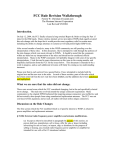


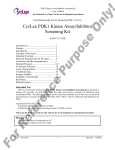
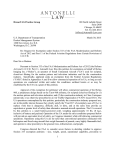
![[4910-13-U] DEPARTMENT OF TRANSPORTATION Federal](http://vs1.manualzilla.com/store/data/005730800_1-83b69f38eee92750e4a30066087ffbc6-150x150.png)
